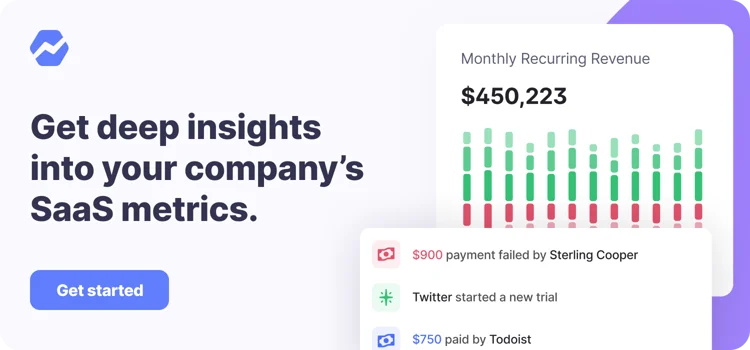Table of Contents

While we’ve spoken at length about working on financial modeling for your SaaS business, it’s important not just to have that data—you need to apply it. In addition to your financial model, you need to select a SaaS sales model that helps you improve the metrics and grow your business.
Other sources, such as our friend Joel York at Chaotic Flow, have written tons about this topic. For more on SaaS sales models, definitely check out his site!
Keep reading to learn about the 3 main SaaS sales models, what makes each model different, and how you can use them in your business.
The Self-Service Model
In this model, you don’t need a sales team. Instead, you’ll focus on creating an extremely robust marketing strategy.
By attracting audiences with inbound marketing efforts, SaaS businesses using the self-service sales model can minimize their operating cost through marketing automation and effectiveness.
With self-service sales, it’s extremely important to offer an excellent customer experience with seamless access to support. If customers can’t find what they’re looking for on their own or get access to the assistance they need, they’ll take their business to one of your competitors.
This model is most effective for lower price point and B2C SaaS products with a high volume of transactions rather than larger, more expensive products.
If you’re a “freemium” app that works by offering both a free version (with restrictions), it’s great to let users decide that the upgrade is worth it on their own. It also works well if you’re an early-stage startup since you likely don’t have the resources to devote to a team of sales reps.
When you want your potential customers to make a more significant investment in a higher priced product, they may require some additional persuasion from a sales professional and benefit from strategies behind other SaaS sales models.
The Transactional Model
This model is the most widely-used SaaS model because it works well for businesses of all sizes.
In this model, the marketing team will focus primarily on lead generation and turning them into qualified leads, while the sales team will drive conversions through lower stages of the funnel.
It’s critical for sales and marketing to work together—for instance, the marketing team might develop a strategy around a free trial, and it will be the responsibility of the sales team to follow up on those trials and drive retention and loyalty.
With the transactional model, it’s easy to fall into the trap of focusing too much on customer acquisition and not enough on retention.
Businesses who let these efforts fall out of balance experience higher churn rates, which can dramatically impact long-term success.
If you use the transactional model, it’s important to consistently monitor your transactions with the most up-to-date data.
Start with a free trial of Baremetrics to monitor and improve churn rate, customer retention, and other key subscription metrics.
Want to Reduce Your Churn?
History Hit uses Baremetrics to measure churn, LTV and other critical business metrics that help them retain more customers. Want to try it for yourself?
The Enterprise Model
This model is the most complex, and with good reason—enterprises are dealing with large budgets, large purchases, and large amounts of data.
Rather than buying a single seat in a SaaS product, enterprises will likely need to equip a full team with access to your SaaS product. In turn, you’ll need to equip a force of salespeople and customer success folks to meet the needs of the many stakeholders and users involved in a SaaS enterprise agreement.
Enterprise SaaS sales also involve restrictions around budgeting, expenses, and approvals. The enterprise sales process is, therefore extremely hands-on, and involves sales reps working on lead generation and direct prospecting of key individuals within target organizations.
New customers will need assistance with onboarding and setup, making customer support absolutely critical for long-term retention.
If you’re offering a more expensive, complex B2B product, the enterprise model will likely work well for your SaaS business. You need to be aware that you’ll need to make a significant investment in your sales and customer management teams.
Equip them with everything they need to attract those high-dollar customers and incentivize your top-performing team members to stay with your company with attractive commission and benefits packages.
Choosing the Right SaaS Sales Model
When it comes to choosing the best Saas model for your business, you need to consider a few key factors:
- How fast is your typical SaaS sales cycle?
- How long does it take for an individual to convert from lead to customer?
- Do you have access to expert SaaS sales reps?
- Is your SaaS product pricing best suited to customer independence, or do you need to offer a helping hand to persuade leads to convert?
It’s also important to make sure your SaaS financial model aligns with your sales model. After all, effective forecasting helps ensure your operating model, cash flow, and budgets support your sales and marketing strategy.
Track the efficacy of your sales model with Baremetrics
It’s easiest to select a sales model if you have accurate data from an SaaS financial modeling software.
Look for a tool that seamlessly integrates with your website, marketing strategy, and payment processing platform to gather all relevant data.
The best tool will not only offer a current status on your cash flow, customer acquisition cost (CAC), and gross profit, but also predict your business’s future monthly recurring revenue (MRR) based on up-to-the-minute subscription data.
Baremetrics has robust capabilities for sales and financial modeling, designed with SaaS and eCommerce businesses in mind.



